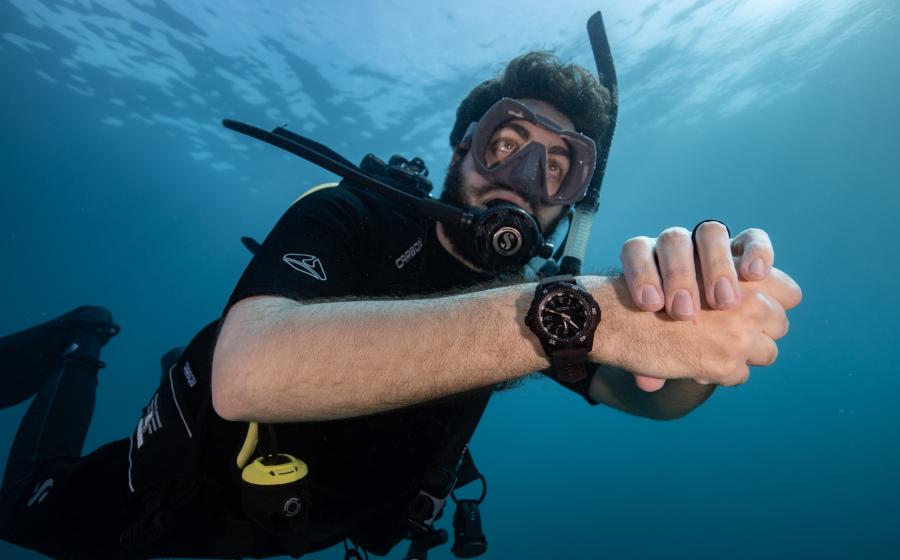Shark Identification
Shark Identification
Historically, sharks left the area when scuba divers entered the water. The bubbles from the regulators scare them off. Since shark dives started in the Bahamas many of the sharks have lost their fear of these bubbles. Has that made them more aggressive towards divers? No, but your chance of seeing a shark on a non-shark dive has increased greatly. Instead of diverting their course several hundred feet away from you, they now continue their planned course that frequently brings them close enough to be seen. This is a list of the sharks that have been seen on our trips:
Caribbean Reef Shark (Carcharhinus perezi)
They are the most common sharks and cruise the offshore reefs. The Caribbean reef shark is the primary shark on the shark feeding dive. They range in length from 5' to 8' to 10'. The tips of their fins and the lower lobe of their tail are dusky. The blacktip shark also has dusky tips, but its anal fins are pale to white. The first dorsal fin is relatively small and begins behind the pectoral fins. Little is known about the Caribbean reef shark's biology. Females bear 4 to 6 pups per litter. It primarily feeds upon fish.
Nurse Shark (Ginglymostoma cirratum)
During the day they are normally found sleeping on the bottom under ledges. They are one of the few sharks that have the ability to bite its tail. Because they look harmless, divers have been known to grab them by the tail, causing the nurse to turn and bite its tormentor. This has made the nurse shark the most common shark involved in human shark attacks. Fortunately it has very small teeth and the bites are seldom serious. On our shark dives the nurse sharks like to harmlessly cuddle up to divers. They range in size from 5' to 9', reaching a maximum length of 14'. They have two barbells on their upper lip. Both of their dorsal fins are approximately the same size and are set far back on their body. They lack a noticeable lobe on their tail. It feeds primarily at night on bottom-dwelling invertebrates, such as lobster and other crustaceans. Mating is in the spring. During this time, the female swims into shallow water to avoid mating with undesirable males. The males bite onto her pectoral fins and try to drag her into deeper water to mate. She finally submits when she decides the male is desirable. There are several areas in the Exumas where nurse sharks are known to mate.
Silky Shark (Carcharhinus falciformis)
Schools of juvenile silky sharks are frequently seen in the summer at the blue hole and at the offshore sea buoy. They leave both of these sites in the fall. It is not known where they go. Silkys are normally open-water sharks. The females reach sexual maturity at a length of 7'. They give birth to 6 to 14 young. Adults range in size from 5' to 7', reaching a maximum length of 10'. The sharks we see range from 2' to 3'. Their first dorsal fin is relatively small, rounded and starts behind the pectoral fins. Their second dorsal fin is small and has a long trailing edge.
Scalloped Hammerhead (Sphyma lewini)
Divers occasionally see scalloped hammerheads swimming over the reefs or along the walls. The unusual video at right was shot during one of our shark dives. Females bear from 15 to 30 pups, each 17" to 22" long. Adults range from 5' to 9', with a maximum length of 14'. The front edge of the hammer has a scalloped look. The inside tip of the pectoral fins are dark.
Whale Shark (Rhincodon typus)
Whale sharks are seen only in winter. Some winters we don't see any and other years they are seen most weeks. It is the world's largest living fish. These gentle creatures don't seem to mind divers approaching them. While most people think they are only a plankton eater, they frequently eat fish as large as tuna. We recently observed this behavior when a whale shark's mouth broke the surface in the middle of a school of feeding tunas. Its body was perpendicular to the surface with its tail straight down. It stayed in this position waiting for tuna to jump into its mouth. Whale sharks range from 20' to 45' with a maximum length of 55'. They are covered by large white spots. The females give live birth to as many as several hundred young.
Lemon Shark (Negaprion brevirostris)
Lemon sharks are known to breed at several locations in the Bahamas including the Exumas. The young lemon sharks stay in the shallow waters around mangroves and in the grass beds until they are about 5' long. They swim the same route every day. Until recently, we had two that swam by the park headquarters every day at the same time. They are also seen in the creeks at Shroud Cay. Lemon sharks range from 5' to 8', reaching a maximum length of 11'. Their second dorsal fin is almost as large as the first. They have a short, blunt, rounded snout. They feed upon bony fishes, rays, crustaceans and mollusks. Females reach sexual maturity at 8' in length. They mate in the spring and summer and give berth to between 4 & 17 live young one year later.
Atlantic Sharpnose Shark (Rhizoprionodon terraenovae)
The sharpnose shark is a very shy shark that inhabits the shallow coastal waters. If you are lucky enough to see one, it is likely to be as it swims away rapidly. It is a common prey for larger sharks. Sharpnose sharks range from 2' to 3' with a maximum of 3'. They have a long flattened snout. Their second dorsal fin begins above the middle of the anal fin and is much smaller then the first. Adults usually have a few scattered spots on their back. Their gestation period is from 10 to 11 months with a litter of 2 to 6 pups, each about 1' long. They feed upon small fish and invertebrates such as shrimp and snails.
Tiger Sharks (Galeocerdo cuvier)
Although the tiger shark is considered to be one of the most dangerous sharks, they tend to swim away from divers. Our few sightings have been of sharks in the distance. Tiger sharks range from 7' to 12' with a maximum of 24'. Their lifespan is estimated at 50 years. They have dark blotches on their body. They will eat almost anything with their most common food being turtles, sharks and seabirds. They have a reputation for being the garbage cans of the seas. They have been found with the following in their stomachs: license plates, grass, tiles, cardboard, ropes, shoes, barrels, tin cans, bottles and a birth control container. They give birth to between 12 and 80 pups after a gestation of 12 months.
Rays
Although most people don't realize it, rays are also in the same family as sharks. We commonly see three types of rays; spotted eagle rays (Aetobatus narinari), southern stingrays (Dasyatis americana), and yellow stingrays (Urolophus jamaicensis). Manta rays (Manta birostris) have been seen by a few lucky divers, but are very rare in the Bahamas.










